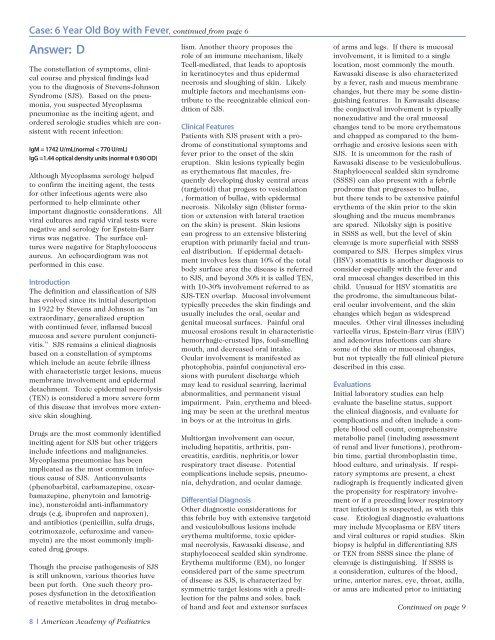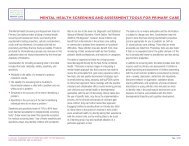Susan Wu, MD, FAAP, Editor - American Academy of Pediatrics
Susan Wu, MD, FAAP, Editor - American Academy of Pediatrics
Susan Wu, MD, FAAP, Editor - American Academy of Pediatrics
You also want an ePaper? Increase the reach of your titles
YUMPU automatically turns print PDFs into web optimized ePapers that Google loves.
Case: 6 Year Old Boy with Fever, continued from page 6<br />
Answer: D<br />
The constellation <strong>of</strong> symptoms, clinical<br />
course and physical findings lead<br />
you to the diagnosis <strong>of</strong> Stevens-Johnson<br />
Syndrome (SJS). Based on the pneumonia,<br />
you suspected Mycoplasma<br />
pneumoniae as the inciting agent, and<br />
ordered serologic studies which are consistent<br />
with recent infection:<br />
IgM = 1742 U/mL(normal < 770 U/mL)<br />
IgG =1.44 optical density units (normal � 0.90 OD)<br />
Although Mycoplasma serology helped<br />
to confirm the inciting agent, the tests<br />
for other infectious agents were also<br />
performed to help eliminate other<br />
important diagnostic considerations. All<br />
viral cultures and rapid viral tests were<br />
negative and serology for Epstein-Barr<br />
virus was negative. The surface cultures<br />
were negative for Staphylococcus<br />
aureus. An echocardiogram was not<br />
performed in this case.<br />
Introduction<br />
The definition and classification <strong>of</strong> SJS<br />
has evolved since its initial description<br />
in 1922 by Stevens and Johnson as “an<br />
extraordinary, generalized eruption<br />
with continued fever, inflamed buccal<br />
mucosa and severe purulent conjunctivitis.”<br />
SJS remains a clinical diagnosis<br />
based on a constellation <strong>of</strong> symptoms<br />
which include an acute febrile illness<br />
with characteristic target lesions, mucus<br />
membrane involvement and epidermal<br />
detachment. Toxic epidermal necrolysis<br />
(TEN) is considered a more severe form<br />
<strong>of</strong> this disease that involves more extensive<br />
skin sloughing.<br />
Drugs are the most commonly identified<br />
inciting agent for SJS but other triggers<br />
include infections and malignancies.<br />
Mycoplasma pneumoniae has been<br />
implicated as the most common infectious<br />
cause <strong>of</strong> SJS. Anticonvulsants<br />
(phenobarbital, carbamazepine, oxcarbamazepine,<br />
phenytoin and lamotrigine),<br />
nonsteroidal anti-inflammatory<br />
drugs (e.g, ibupr<strong>of</strong>en and naproxen),<br />
and antibiotics (penicillin, sulfa drugs,<br />
cotrimoxazole, cefuroxime and vancomycin)<br />
are the most commonly implicated<br />
drug groups.<br />
Though the precise pathogenesis <strong>of</strong> SJS<br />
is still unknown, various theories have<br />
been put forth. One such theory proposes<br />
dysfunction in the detoxification<br />
<strong>of</strong> reactive metabolites in drug metabo-<br />
8 | <strong>American</strong> <strong>Academy</strong> <strong>of</strong> <strong>Pediatrics</strong><br />
lism. Another theory proposes the<br />
role <strong>of</strong> an immune mechanism, likely<br />
Tcell-mediated, that leads to apoptosis<br />
in keratinocytes and thus epidermal<br />
necrosis and sloughing <strong>of</strong> skin. Likely<br />
multiple factors and mechanisms contribute<br />
to the recognizable clinical condition<br />
<strong>of</strong> SJS.<br />
Clinical Features<br />
Patients with SJS present with a prodrome<br />
<strong>of</strong> constitutional symptoms and<br />
fever prior to the onset <strong>of</strong> the skin<br />
eruption. Skin lesions typically begin<br />
as erythematous flat macules, frequently<br />
developing dusky central areas<br />
(targetoid) that progess to vesiculation<br />
, formation <strong>of</strong> bullae, with epidermal<br />
necrosis. Nikolsky sign (blister formation<br />
or extension with lateral traction<br />
on the skin) is present. Skin lesions<br />
can progress to an extensive blistering<br />
eruption with primarily facial and truncal<br />
distribution. If epidermal detachment<br />
involves less than 10% <strong>of</strong> the total<br />
body surface area the disease is referred<br />
to SJS, and beyond 30% it is called TEN,<br />
with 10-30% involvement referred to as<br />
SJS-TEN overlap. Mucosal involvement<br />
typically precedes the skin findings and<br />
usually includes the oral, ocular and<br />
genital mucosal surfaces. Painful oral<br />
mucosal erosions result in characteristic<br />
hemorrhagic-crusted lips, foul-smelling<br />
mouth, and decreased oral intake.<br />
Ocular involvement is manifested as<br />
photophobia, painful conjunctival erosions<br />
with purulent discharge which<br />
may lead to residual scarring, lacrimal<br />
abnormalities, and permanent visual<br />
impairment. Pain, erythema and bleeding<br />
may be seen at the urethral meatus<br />
in boys or at the introitus in girls.<br />
Multiorgan involvement can occur,<br />
including hepatitis, arthritis, pancreatitis,<br />
carditis, nephritis,or lower<br />
respiratory tract disease. Potential<br />
complications include sepsis, pneumonia,<br />
dehydration, and ocular damage.<br />
Differential Diagnosis<br />
Other diagnostic considerations for<br />
this febrile boy with extensive targetoid<br />
and vesiculobullous lesions include<br />
erythema multiforme, toxic epidermal<br />
necrolysis, Kawasaki disease, and<br />
staphylococcal scalded skin syndrome.<br />
Erythema multiforme (EM), no longer<br />
considered part <strong>of</strong> the same spectrum<br />
<strong>of</strong> disease as SJS, is characterized by<br />
symmetric target lesions with a predilection<br />
for the palms and soles, back<br />
<strong>of</strong> hand and feet and extensor surfaces<br />
<strong>of</strong> arms and legs. If there is mucosal<br />
involvement, it is limited to a single<br />
location, most commonly the mouth.<br />
Kawasaki disease is also characterized<br />
by a fever, rash and mucus membrane<br />
changes, but there may be some distinguishing<br />
features. In Kawasaki disease<br />
the conjuctival involvement is typically<br />
nonexudative and the oral mucosal<br />
changes tend to be more erythematous<br />
and chapped as compared to the hemorrhagic<br />
and erosive lesions seen with<br />
SJS. It is uncommon for the rash <strong>of</strong><br />
Kawasaki disease to be vesiculobullous.<br />
Staphylococcal scalded skin syndrome<br />
(SSSS) can also present with a febrile<br />
prodrome that progresses to bullae,<br />
but there tends to be extensive painful<br />
erythema <strong>of</strong> the skin prior to the skin<br />
sloughing and the mucus membranes<br />
are spared. Nikolsky sign is positive<br />
in SSSS as well, but the level <strong>of</strong> skin<br />
cleavage is more superficial with SSSS<br />
compared to SJS. Herpes simplex virus<br />
(HSV) stomatitis is another diagnosis to<br />
consider especially with the fever and<br />
oral mucosal changes described in this<br />
child. Unusual for HSV stomatitis are<br />
the prodrome, the simultaneous bilateral<br />
ocular involvement, and the skin<br />
changes which began as widespread<br />
macules. Other viral illnesses including<br />
varicella virus, Epstein-Barr virus (EBV)<br />
and adenovirus infections can share<br />
some <strong>of</strong> the skin or mucosal changes,<br />
but not typically the full clinical picture<br />
described in this case.<br />
Evaluations<br />
Initial laboratory studies can help<br />
evaluate the baseline status, support<br />
the clinical diagnosis, and evaluate for<br />
complications and <strong>of</strong>ten include a complete<br />
blood cell count, comprehensive<br />
metabolic panel (including assessment<br />
<strong>of</strong> renal and liver functions), prothrombin<br />
time, partial thromboplastin time,<br />
blood culture, and urinalysis. If respiratory<br />
symptoms are present, a chest<br />
radiograph is frequently indicated given<br />
the propensity for respiratory involvement<br />
or if a preceding lower respiratory<br />
tract infection is suspected, as with this<br />
case. Etiological diagnostic evaluations<br />
may include Mycoplasma or EBV titers<br />
and viral cultures or rapid studies. Skin<br />
biopsy is helpful in differentiating SJS<br />
or TEN from SSSS since the plane <strong>of</strong><br />
cleavage is distinguishing. If SSSS is<br />
a consideration, cultures <strong>of</strong> the blood,<br />
urine, anterior nares, eye, throat, axilla,<br />
or anus are indicated prior to initiating<br />
Continued on page 9



